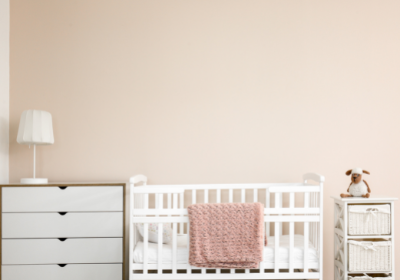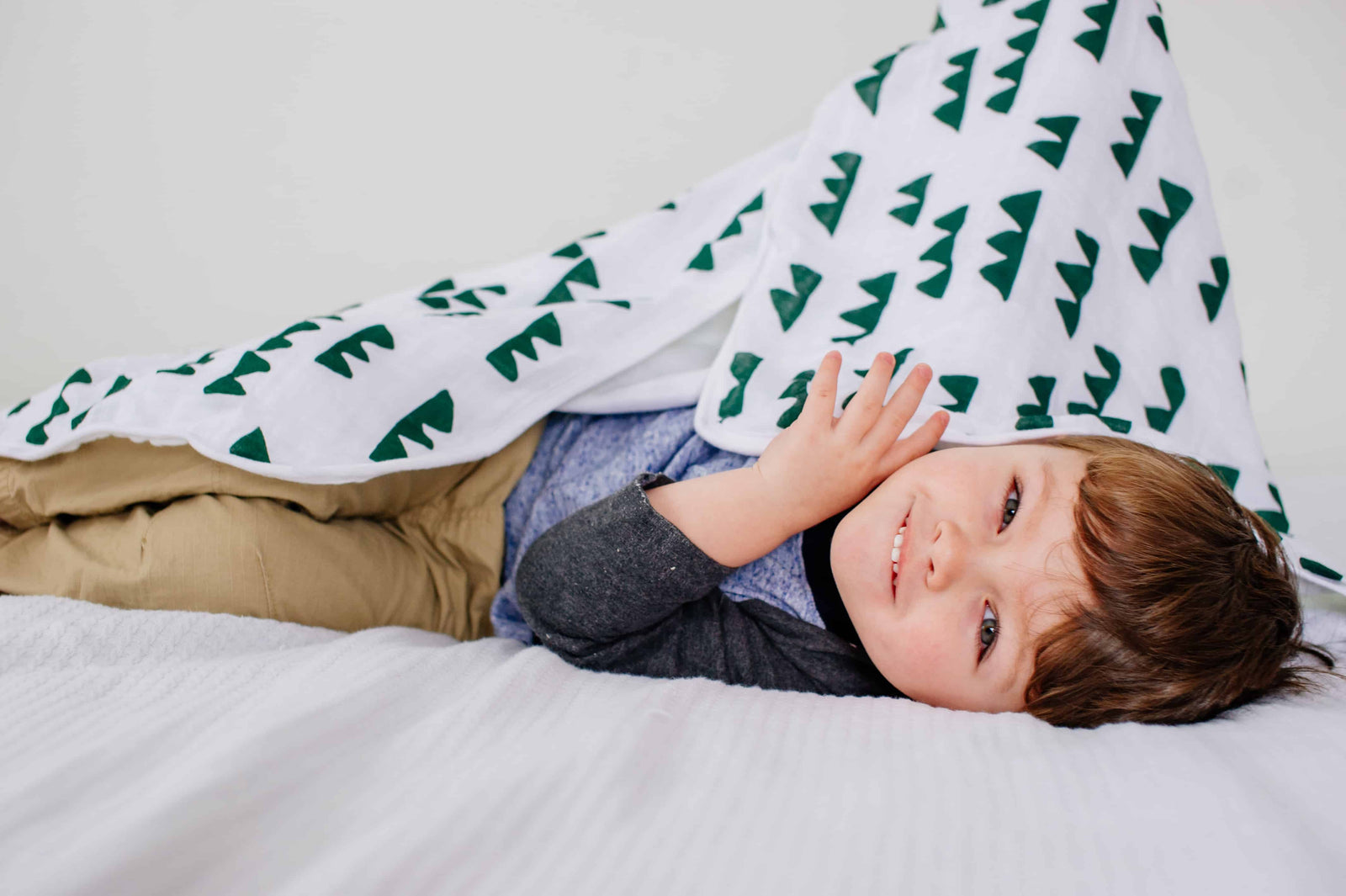Babies may not be able to tell us how they feel, but watching them scratch at red, inflamed skin certainly gets the point across. There’s nothing worse than seeing your baby suffer from pain and discomfort, and we know exactly how it feels. Eczema is a topic close to our hearts, as our son was diagnosed with it as an infant. Although we were told that he would likely have to live with it, we made it our mission to relieve his near-constant discomfort.

Our son Alex was diagnosed with eczema when he was a baby
Through research, as well as trial and error, we found that diet is the best way to prevent eczema in the first place. We had success with breathable, hypoallergenic bamboo crib sheets, bassinet sheets, and sleep sacks. While our products are certainly not a remedy for any skin condition, the soothing fabric helps prevent further irritation. Read on to find out what worked best for us when we were exhausted, first-time parents just trying to manage our baby’s skin condition.
What is Eczema?
Eczema, also known as atopic dermatitis, is a common skin condition that causes dry and scaly patches on the skin that can be extremely itchy. Eczema treatment and prevention usually include:
- Corticosteroid ointments
- Moisturizing creams
- Avoidance of skin irritants and, in certain cases, food allergens
- Diet adjustment
If your child has lighter skin, the patches will likely be red, while they usually look purple, brown, or gray on children with darker skin. Atopic dermatitis in infants is typically found in large patches on the body, and on the cheeks and head. As your child gets older, patches may be on the inside of elbows, knees, and wrists, or around the neck, hands, eyes, and ears.

Eczema causes dry and scaly patches on the skin
Severe eczema can crack, bleed, weep, and even blister. To avoid this, it’s important to try to isolate your child’s triggers. Keeping a journal of their flare-ups, seeing an allergist, and avoiding scented, chemical-laden products can help narrow down the issue.
What Causes Atopic Dermatitis?
It’s a long-term skin condition that often begins in infanthood, although you can get it at any age. While some outgrow eczema as teenagers, it may be a lifelong condition. You have a higher chance of having it if you are female, African-American, also have asthma or hay fever, or if you have a family history of atopic dermatitis, asthma, or hay fever.
It is not contagious and cannot be spread from person to person. It’s caused by a combination of genetics, your environment, and an overactive immune system that’s sensitive to irritants. Flare-ups can also be caused by stress.
While most people’s skin has a barrier that helps keep moisture in and prevent irritants from entering, skin with eczema has a less effective barrier. Water and moisture are more easily lost, while irritants and allergens can more easily permeate the skin.
How to Prevent Flare-Ups & Manage Symptoms
As parents, there’s nothing we wouldn’t do to ease our child’s discomfort. Luckily, there are a handful of common eczema triggers that can be avoided to manage symptoms. Keep in mind that managing this skin condition is very much trial and error, but worth the effort.

Different ways you can avoid eczema
Environmental & Food Allergies
20% of children have atopic dermatitis, and 30% of those children also have food allergies. If your child develops eczema, they are at increased risk for developing food allergies. However, isolating and avoiding your child’s food allergies or sensitivities can help manage or clear up dry patches.
That’s not the case for many children, so experts caution parents not to assume that there must be a certain food allergy to blame. Book an appointment with an allergist if you suspect your child has a pediatric allergy. Allergens such as pollen, dust, smoke, and pet dander can also irritate your child’s skin.
Taking a Look at Your Child’s Diet
Diet is one of the best ways to manage your child’s eczema. Choosing foods that are high in probiotics is crucial for promoting good skin and gut health. People with atopic dermatitis may suffer from a histamine overload, which can also cause a leaky gut. To improve digestion and eczema symptoms, try a low-histamine, spore-based probiotic and a balanced, low-histamine diet.

High-histamine foods to avoid when your baby has eczema
Avoid high-histamine foods:
- Dairy
- Citrus fruits
- Bananas
- Tomatoes
- Spinach
- Cured meats
- Aged cheeses
- Artificial preservatives and dyes
Choose low-histamine foods:
- Apples
- Onions
- Pomegranates
- Broccoli
- Most fresh fruits and veggies
- Meats, and fish

Go for these low histamine food if your baby has eczema
To read more about how histamine intolerance could be impacting your child’s skin condition, we recommend starting here. Some people also have success with eliminating gluten. Always talk to your child’s doctor before eliminating food groups or choosing a probiotic.
Manage Temperature at Home
Cold, dry air and low humidity can easily dry out your skin. You know how scaly and rough your skin feels in the winter? It’s even worse for kids with eczema, who tend to get extra itchy, irritated skin in cold weather. Also, while cold weather dries out skin, so does central heating. While it may seem like cranking up the heat will combat cold weather dryness, it’s not the case.
Don’t overheat your house, and make sure your child doesn’t stand in front of any heating source. Sweating due to hot weather can also irritate the skin and cause flare-ups. Bamboo fabric is both absorbent and temperature-regulating, which helps prevent moisture and sweat from gathering on the skin during sleep. You can also check out our tips for combating the summer heat and setting the ideal temperature in your home during any season.
Avoid Scratchy, Rough Fabrics

Choose organic and breathable fabric for your sheets and towel
We originally discovered our love of bamboo out of desperation to help our son’s sensitive skin. It helped him tremendously, and we’ve been lucky enough to be able to help other parents soothe their child’s skin with our products. Sleeping on and wearing rough, synthetic fabrics can make irritated skin worse, while a lightweight, breathable, and natural fabric like bamboo is extremely gentle on itchy skin.
Try our crib sheets, bassinet sheets, and sleep sacks for a better night’s sleep for all. Still not sold on the magical properties of bamboo? Here are five reasons it’s the best for eczema in babies.
Creams & Ointments
For most parents, this is where the trial and error comes in. The cream or lotion that works best for one child may do nothing for another. You will want to try a mild, fragrance-free moisturizing cream or an ointment like petroleum jelly or Aquaphor. With any new product, test it on a small area of the skin. Once you find what works best, moisturize the skin at least twice a day.

Consult with your doctor before using any ointment or cream
Your doctor may prescribe a corticosteroid cream for flare-ups, and hydrocortisone cream is available over the counter. There is also a non-steroidal cream called pimecrolimus that can help with mild skin inflammation. The FDA recently approved Opzelura, a JAK inhibitor, to treat mild to moderate atopic dermatitis. Although it’s for adults and children 12 and older, new treatments are promising. While prescribing creams is a common approach for severe cases, always consult your pediatrician or dermatologist before using any ointments on your child’s skin.
Harmful Ingredients
You must choose the products you use very carefully. Anything that touches their skin— detergent, skin care products, lotion, body wash, wipes, and dryer sheets— can all make their flare-ups worse. To choose the best products for your child:
- Avoid ANY chemical fragrance
- Avoid these skin-irritating ingredients
- Avoid essential oils or scented products
- Choose products with natural, gentle ingredients

Choose skincare and household products with natural and mild ingredients
You may have to try a few different products before finding the one that works best for your child, which can be frustrating and expensive, but ultimately worth it. Some of our favorite products include Molly’s Suds, Branch Basics, Beautycounter, and Honest.
Cool Baths & Quick Tips
A warm or even cool bath can help soothe your child’s skin. Keep the bath short, wash any irritants from their skin with a mild soap, pat dry with a soft towel, and moisturize afterward. The best time to moisturize their skin is right after a bath or shower, when it will sink in the most.
After bathing and moisturizing, dress them in light fabrics like cotton, muslin, or bamboo. A cool washcloth can help extra itchy patches, and a cool-mist humidifier can add much-needed moisture to the air.

Give baby a cool bath to soothe skin or use a cool washcloth to relieve itching
There is a method called “wet wrapping” that some doctors recommend to ease symptoms and inflammation. Talk to your pediatrician or dermatologist to see if it may help your child.
How to Avoid Itching & Scratching
We know firsthand how hard it is to get an infant to stop scratching at dry skin! During their waking hours, try to distract them by reading, playing, and singing. Many babies will try to scratch their faces and heads on rough sheets for relief. To prevent skin irritation during sleep, use the softest sheets you can find. Did we mention we love bamboo? The buttery soft fabric is chemical-free, eco-friendly, and incredibly breathable.

To prevent irritation during sleep, use butter-soft fabrics like bamboo
Trim your baby’s nails often, and keep them clean to prevent infection. If all else fails, keep mittens or socks on their hands, so they don’t scratch themselves.
When to See A Doctor
While there’s no need to run to the doctor every time your child has a flare-up, you may want to make an appointment with your child’s doctor or dermatologist if:
- The dry patches are new, and you’re seeking a diagnosis and treatment plan.
- You suspect that your child’s dry skin has become infected— the rash is warm to the touch, has pus-filled blisters, a yellow crust, or is oozing.
- Your child develops a fever.
- Their skin is cracked and bleeding.
- Your usual regimen is no longer providing relief.
- Your child is unable to sleep.

Always consult with your doctor if you're not sure about products you want to use for your baby
You may have to seek professional opinions and expertise outside of a pediatrician when dealing with a skin condition. Ask for a referral for a local dermatologist or allergist.
Living With Atopic Dermatitis
Your baby being diagnosed with a potentially lifelong skin condition can feel overwhelming and upsetting, and rightfully so. We’re here to tell you that finding ways to avoid flare-ups, reduce symptoms, and provide relief is entirely possible. You and your child will learn to live with eczema by finding their triggers, as well as the right fabrics, skin care products, creams, and ointments for them. Check out our soft and breathable organic bamboo sheets and swaddles to for eczema-friendly fabrics!






Busymommy
May 08, 2022
Keep your child’s skin clean and moisturised. You should bathe your child regularly with warm water and use mild soap if necessary. Rinse well with warm water afterwards – this will help prevent infections in their skin folds (where water pools). Dry their skin thoroughly afterwards as dampness can lead to more outbreaks of eczema. Apply emollients regularly after bathing or swimming to prevent dryness – choose one based on whether your child has dry or sensitive skin